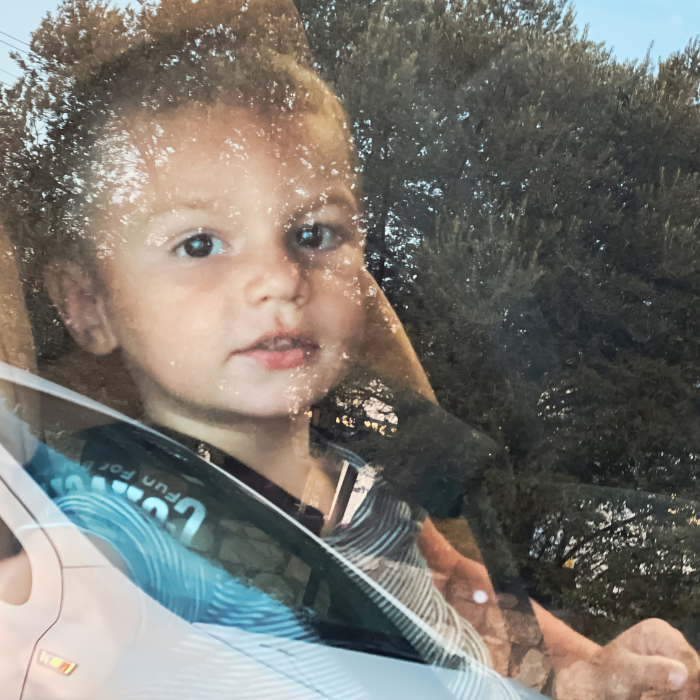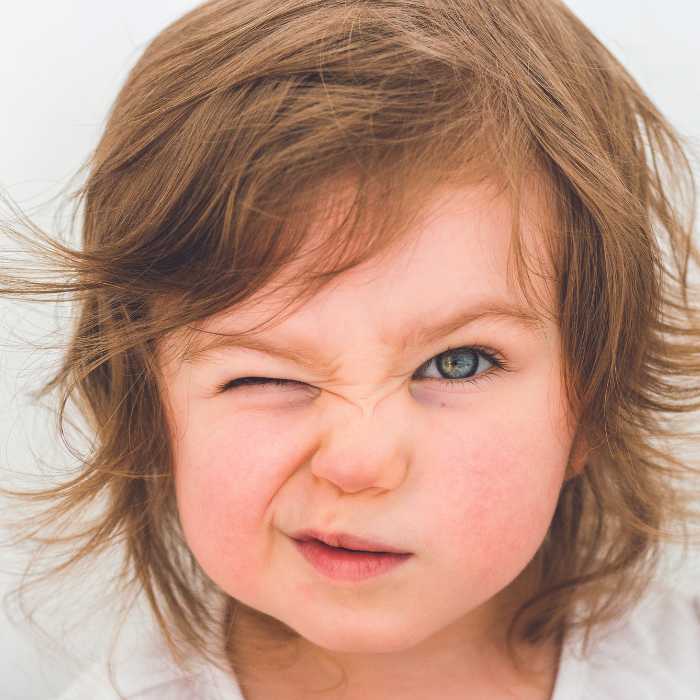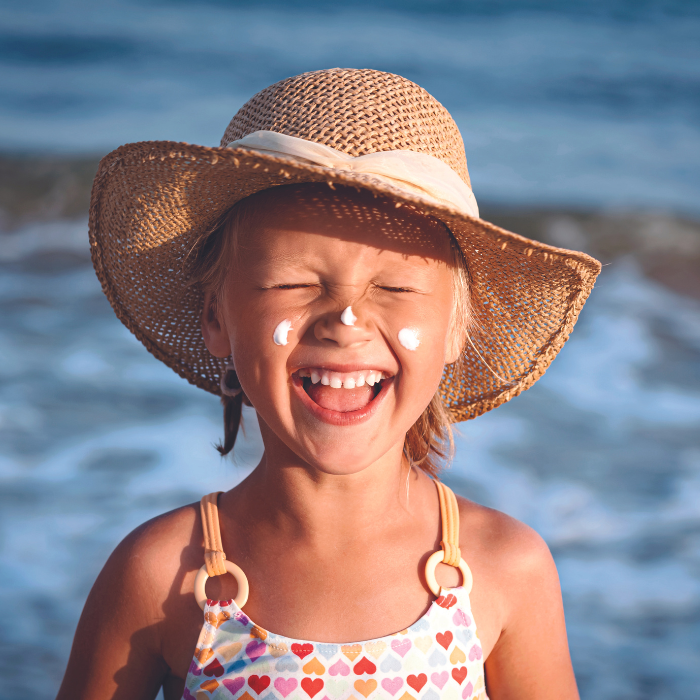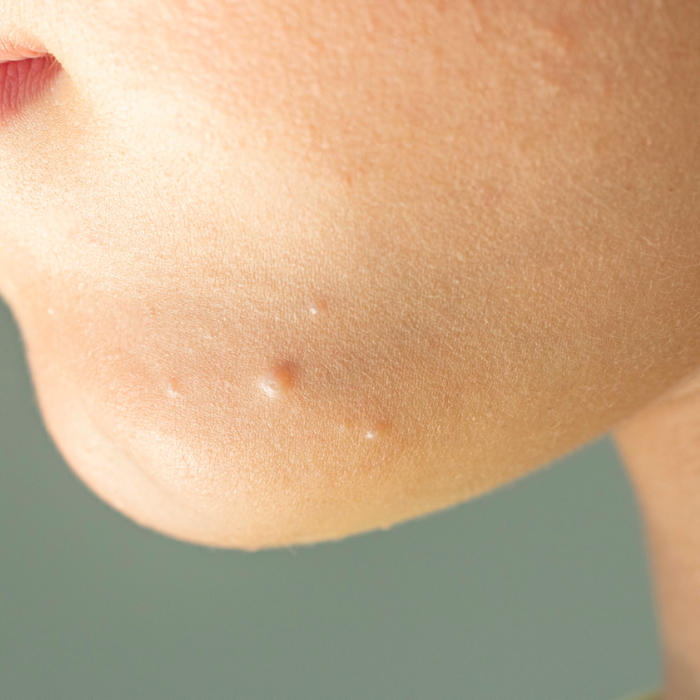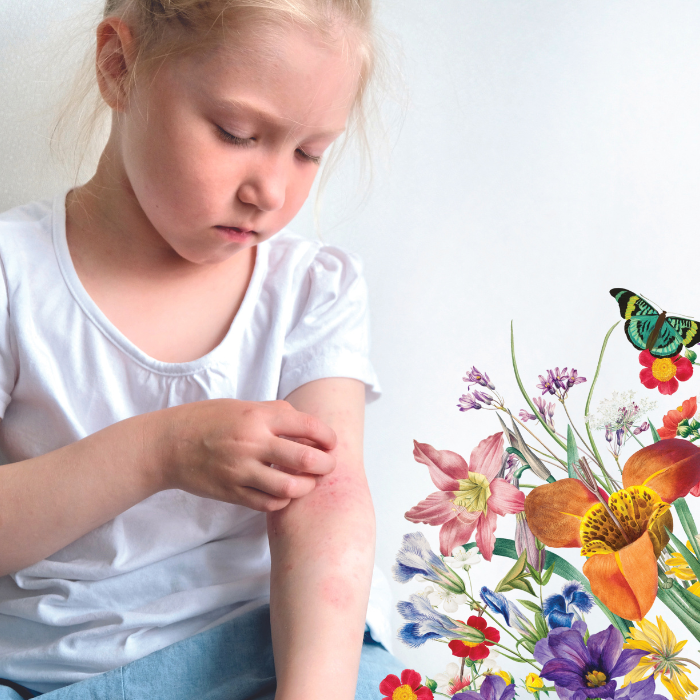
Summer is a great time of year, with lots of opportunities for fresh air and sunshine, but things like sunburn and hay fever can really ruin the fun. Dr. Leila Masson provides us with some ways you an help your child at home.
Swimmer’s ear
The wax in our ears is supposed to be thin and liquid and cover the walls of the ear canal to protect it from infections. When children are low in healthy essential fatty acids, such as omega 3, the wax can become hard and crumbly and block the eardrum instead of forming a thin layer in the ear canal. If the ear becomes wet from swimming, or from having grommets, the small amount of leakage from behind the eardrum into the ear canal is an ideal medium for bacteria to grow. This results in thick, smelly pus draining from the ear. The most common bacteria causing this are pseudomonas, which have a foul smell. The best treatment is to remove the pus with a small, soft, thin wick of cotton (do not insert anything else, not even a cotton swab on a stick into the ear canal) and then apply antibiotic eardrops that are effective against pseudomonas.
Apple cider or white vinegar can reduce the risk of the bacteria regrowing. Put 3–4 drops of a mixture of ½ teaspoon of vinegar mixed with ½ teaspoon of water into the ear canal via a dropper – but ONLY if your child does not have grommets. If your child has grommets, put a little apple cider vinegar on a cloth and gently clean the outside of the ear and the entrance to the ear canal – do not poke or pour anything into the canal.
Hay fever
Hay fever is an allergic reaction to environmental allergens, most commonly caused by pollen from grasses and trees, dust mites, mould and animals. It can be seasonal, for example, it could be caused by a tree that only blooms in springtime, or year-round if caused by grasses that bloom in all four seasons or by other allergens that are persistent. Hay fever can cause a runny nose, itchy eyes, a cough, and can exacerbate asthma and cause trouble breathing. I recommend testing for allergies to find out what your child reacts to. (See page 182 for more on allergy testing.)
What you can do to help?
Allergies can be prevented by breastfeeding, a beneficial gut flora, optimal vitamin D levels and a nutritious diet. All of these factors can also help to improve hay fever symptoms. Reduce the symptoms by optimising your child’s immune system with vitamin C and zinc.
Use antihistamines. Several prescription antihistamines are available (they are relatively safe, even in the long-term, but do have potential side effects and they are not recommended for children under 1 year of age). And you can also use a natural alternative, called quercetin. Given twice daily this can reduce allergic reactions – start a child on 50mg twice daily and if needed increase to 100mg twice daily.
Strengthen cell membranes of mast cells to help avoid the release of histamine and the cascade of inflammation by giving calcium, vitamin C and bioflavonoids. Mast cells are the immune cells that release histamine in an allergic reaction. Histamine is released when the body detects an allergen. It causes inflammation by increasing the permeability of capillaries (tiny blood vessels) and lets inflammatory white blood cells and proteins enter the tissue – causing swelling, itching and redness.
In the long-term you can get your child desensitised against allergens. Immunologists and other doctors do this by applying very diluted doses of the allergens either orally or by injection and slowly increasing the concentration to get the immune system used to the allergen and eventually help the body overcome the allergy altogether.
In a simlar way, you can also increase tolerance of allergens by having your child consume nettle tea or eat locally made honey – which contains small amounts of local pollen and helps your body get used to it and cause less of a reaction.
Cold sores and fever blisters (herpes virus)
Herpes virus can cause cold sores or fever blisters on the lips. Once you have had them, they can come back at any time the herpes virus is triggered. So it is important to know the triggers for your child’s cold sores and avoid them. Triggers can include stress, fatigue, infection, sunburn, a cold, too many foods high in L-arginine (sesame seeds, chocolate, cola, gelatin, peas, or soy protein isolate which is found in many processed foods).
What you can do?
For treatment, the first step is not to touch the blisters, as that is how they are spread. Then boost the immune system with good food, rest and vitamin C and zinc. If the sore is very painful, you can cool and numb it by applying an ice cube for a few seconds or up to a minute. There is also a range of natural topical treatments that can help. First, wash the area with water. Then apply vanilla extract, witch hazel or peppermint oil to the sore with a cotton swab. These can all stop the virus from spreading. You can mix the active ingredient into a small amount of aloe vera, which is cooling and soothing.
Tea tree oil is also a powerful antiviral, but should not be swallowed. If your child is old enough not to lick the tea tree oil off, apply a few drops of tea tree oil mixed into either water or aloe vera and apply to the sore. Applying crushed garlic also works, but I have yet to meet a young child who can stand the stinging or the taste!
You can apply lysine cream or take a lysine supplement. If your child suffers from recurrent cold sores, it may be a good idea to give L-lysine for a few weeks and to always start it at the first tingling symptoms of a new cold sore. Other supplements that may be helpful are liquorice, oregano and olive leaf extract, which you can get as topical skin ointments or as syrup. Support the immune system, give extra vitamin C and E, echinacea or goldenseal.
Discard your child’s toothbrush or toothbrush head every time she has a cold sore to avoid reinfection.
If you cannot get on top of the blisters and they continue to spread instead of healing, take your child to the doctor. She may need an antiviral prescription medication, such as acyclovir cream.
Sunburn
The most important thing about sunburn is to avoid it! Even just one blistering sunburn in childhood doubles the risk of getting melanoma as an adult. Children in New Zealand and Australia, where UV (ultraviolet) radiation is very high due to the hole in the ozone layer, need to be extra well protected.
The best protection is physical: avoid the direct sun at high UV times. You can measure the intensity of the radiation with a handheld UV meter (from a hardware store) and judge how safe it is to play outdoors or check your weather report for UV levels. If radiation levels are high, remember to ‘slip, slop, slap and wrap’: cover your child with a hat, a long-sleeved shirt and a non-toxic sunscreen and put on sunglasses to protect the eyes from harsh UV rays, which can increase the long-term risk of cataracts.
When looking for a sunscreen, choose one that has no chemical ingredients and only zinc oxide as the active ingredient. The Environmental Working Group (www.ewg.org) has an extensive list of safe options. If it is too late and your child is sunburnt, apply soothing lotions, such as aloe vera (Weleda Burns & Bites Soothing Gel) or calamine and hydrate your child well. Also give vitamin C to boost the immune system, as sunburn can lead to infections due to temporary immune suppression.
Children need some sun exposure to make vitamin D.
In the summer I recommend letting your child play outdoors shirtless for 30 minutes to 1 hour before 9 or 10am and after 4 or 5pm, when the UV radiation is not at dangerous levels. (Always check with your UV meter to make sure.) Even then, watch your child and do not allow sunburn to happen.
Extract printed with permission from Children’s Health A to Z by Dr Leila Masson
Published by David Bateman RRP $29.99



